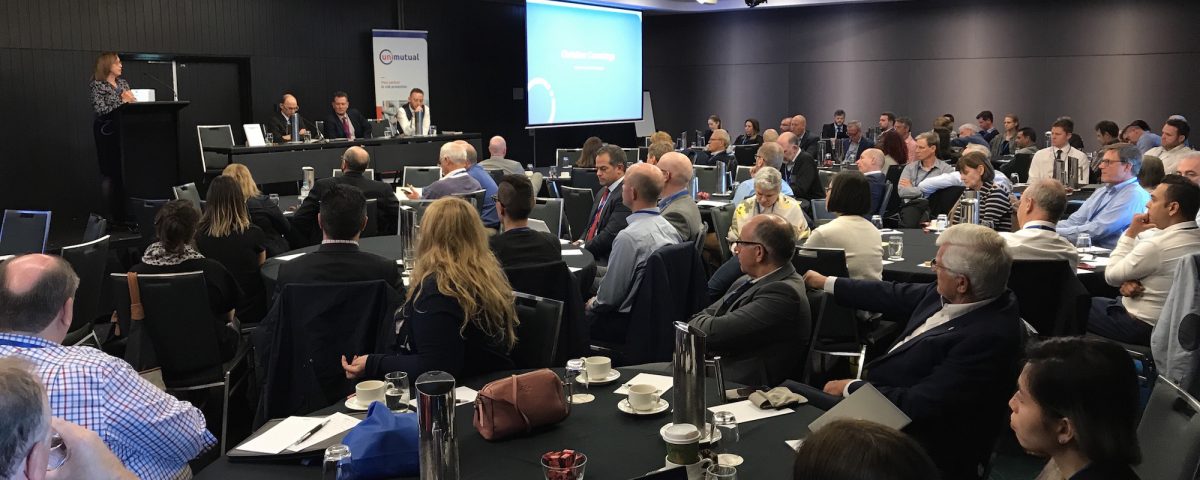
Why Aren’t Risk Management Systems More Addictive?
October 18, 2018
Member Matters Issue #4, 2018
October 26, 2018Flooding, cyber warfare and teaching students to think, taking the big risks, and making them pay off at Unimutual’s 2018 Conference.
It was with great pleasure that we welcomed 120 of our members, re/insurance industry partners, and board, to our 28th annual conference.
In our humble opinion – backed up by your feedback – the conference gets better every year, and its’s a wonderful thing to see faces new and old join us as we discuss the topics that matter most to you.
We are now a mixed bunch – with more than half our members (by number) a variety of non-university organisations, including colleges, guilds, institutes, conservatoriums, research facilities, tertiary educators, and others.
And as we continue to grow and welcome new members, it is more important than ever that we gather to remind ourselves of our commonalities and share the benefit of our experiences and hard-won knowledge.
It was a pleasure to welcome our newest board members, Darren Greentree and David Hanna, and it was with great sadness that we said goodbye to Judy Raper and Jessica Lightfoot.
This year’s theme was ‘taking the big risks’, and we focused on the major themes on everyone’s minds. Few of them were surprising as major concerns, but some surprising things were revealed about them. We hope our overview below will give you food for thought as you continue to consider, and ultimately solve, the ongoing puzzles and challenges in our industry.
Climate change gets real, with a two metre wall of water in Tasmania
It seems every news bulletin now is filled with extreme weather events, often taking place simultaneously somewhere in the world. Severe drought in much of NSW is reported side by side with storms and flooding in other states – more frequent and more extreme than ever before, and increasingly affecting areas that were previously low-risk. 2018 was the worst year on record for storms, and there is general consensus that this may be just the beginning. The worst is yet to come.
In an extreme weather event human safety comes first, but a responsive insurer helps
Who better to talk about managing extreme weather events than Matt Smith and Jarrod Shaw from the University of Tasmania, who lived through (and managed) an extreme storm event which hit Hobart in May this year, causing damage in excess of $100 million and flooding much of the University.
To give an indication of the severity (and unexpectedness) of the storm, it was only the 5th time since 1893 that Hobart recorded more than 100mm of rain and 1,000 lightning strikes in one day. Widespread power outages and a two metre high wall of water breaking through the university grounds saw university buildings inundated with floodwater, and the loss of research equipment and books as well as electrical and mechanical infrastructure.
Evacuation of occupied buildings and student accommodation was the human safety number one priority, followed by restoration of power to safeguard research.
Unimutual was emailed at 7.27am, and called in at 9.01am to work with UTAS to restore and repair, as well as to prepare and action claims – from appointing water damage restoration experts to sending claims assessors for every aspect of the damage.
The key learnings? Other than the fact that UTAS handled the crisis extremely well, (annual training of the team was praised here), the emphasis was put on a nimble CMRP and a constant review of the BCPs.
Big innovations require big risks
From humble beginnings as a divisional satellite of the University of NSW in 1951, the University of Wollongong can justifiably claim to be at the front of the curve when it comes to taking big risks in research, helping start-ups and small business and investing in the infrastructure of the future. “Reaping the Rewards of Big Risks” was the title of the presentation by Professor Judy Raper, Deputy Vice Chancellor (Research & Innovation) at the University of Wollongong.
Retrofitting that icon of non-environmentally friendly Australian housing, the fibro cottage, to transform it into a sustainable 21st century net-zero energy home might seem an insurmountable task. But that’s what the team from UOW did – demonstrating that innovative building energy technology and clever design can produce an affordable, stylish and sustainable home.
But addressing global challenges doesn’t end there. Transformative interdisciplinary research has produced game-changing innovations across the environment, health and manufacturing. From the lymph sleeve to shark conservation, medication management and gamifying activity for children, UOW has taken the risks, and is reaping the rewards.
Black swans, perfect storms and boiling frogs, the biggest risks may well be beyond our current experience
Universities’ and education’s ‘big risks’ continue to be the same concerns that have dominated for some time: finances and students are top of the list. But no one is immune from new and potentially unchartered risk inherent in the growing role and sophistication of technology, according to specialist risk management consultancy Broadleaf’s Dr Dale F Cooper. Hardware capability is increasing rapidly, and systems with new capabilities loom as a threat to university jobs everywhere.
Teaching may rank low when compared with manufacturing on the scale of automation risk, but that doesn’t mean it isn’t at risk at all. New skills are required, a different focus, and a new way of learning – teaching students to think, in fact, rather than teaching them to perform automated tasks that machines can do better. We hear at this year’s UA conference that this is also how we will future-proof tomorrow’s workforces.
And what of the universities themselves? There is an increasing blurring of industry boundaries as non-traditional rivals offer educational services and global competition increases. There are four scenarios that make sense, and it behoves us all to think deeply about which we want, and how to achieve it?
We can champion our universities as strategic national assets or see them more as financially independent commercial entities which collaborate closely with industry. Do they continue to offer a curriculum in the way they have in the past, or do we move to a disruptor university model of continuous learning, with its flow-on effect of micro-certificates in new markets? Or finally, is the integrated model of the virtual university the best – one where vocational institutes and universities are integrated with a focus on employment as opposed to academia?
The perils (and perks) of involving students in research
The thorny issues surrounding research partnerships between universities and commercial partners were highlighted by Danielle O’Doherty, Megan West and Cherry Sui-Ho from the University of Wollongong. When a university partners with a commercial entity to undertake research and is paid for that research, is there a role for student participation? Who protects the university, who the professor and who the student? Who owns the intellectual property, and how do we enforce that?
These are important questions, because if a dispute occurs, and research findings are made public before completion, your university’s reputation (and the reputation of the professor in charge) are very much at stake.
Prevention being better than cure, getting it right from the get-go was the way forward. But what does this mean in practice? It all comes down to knowing your university and student policies, following proper research processes and getting help when something goes wrong – as soon as possible.
The word on everybody’s lips is gonna be “cyber”
Data, cloud services and cyber warfare are the most serious of all cyber exposures now, and will be for the next decade
No matter who you are, insurer or educator, if cyber security and insurance for cyber risk isn’t at the front of your mind, it should be. Max Broodryk from insurer XL Catlin provided startling evidence in the rise of the standalone cyber insurance market in the US, which has grown by 30% in just four years, between 2011 and 2015. Disclosed data breaches have increased from 421 in 2011 to 1,370 in 2015. Note the emphasis on disclosed.
Insurance coverage may have struggled to keep up with runaway sophistication in hackers’ technical abilities, but improvements in the form of broader definitions and fewer sub-limits have been made.
Mr Broodryk’s bigger message though was to highlight three megatrends which he says are complex, intertwined, but ultimately the most fundamental influencers of cyber exposures: data, cloud and ‘cyber warfare’.
Cyber warfare isn’t necessarily war, but it includes espionage, propaganda, sabotage, and, ultimately, terrorism. Just ask Mr Trump, or shipping conglomerate Maersk, which suffered a cyber attack that ended only when the entire global network was disconnected
There are currently significant differences in the way that insurers understand and cover (or don’t cover) cyber risks and provide claims service – we work hard to make sure you are protected, but its key to remember that the first 48 hours in any cyber-attack are critical.
Will robots take our jobs?
40% of jobs in Australia are likely to be automated in the next 10-15 years
Data, digitalisation, diagnostics and disruption was discussed as part of Curtin University’s push to make tomorrow better by studying the impact of artificial intelligence on telecommunications and higher education today.
Diverless cars and the impact of digital disruption are one thing, but the big question is really what skills we require to be effective risk managers. Digitising data effectively, enabling and strengthening innovation though industry engagement and research and improving campus operations in order to make better and more timely risk- informed decisions.
What will the next few years look like for the insurance market?
Our members will know by now that we are entering a period of market hardening. Our underwriting manager Pete Watts wrote about it earlier in the year, but it was good to hear the brokers’ take on the market development. Look out for interviews with our broker partners throughout the coming year for more insights.
Any other risks?
The, other, smaller and/or more frequent risks can be equally important of course, from sporting injuries to emerging drone risks.
Our technical committee, which presented their report on the first day of the conference, looks at all these issues in their work to make sure that the members’ requirements are being met, and hopefully exceeded. The committee reviews protections and services, suggests additional ones, and makes recommendations on enhancements to protections.
The committee also identifies risks that should be borne by the member, and not passed onto the mutual – with the colourful example of pinworms in mice and rats, which should be preventable with better animal husbandry.
It’s impossible to capture all the interesting things that were discussed this year, but many of the presentations are available to members here. And you can sign up to our Member Matters or Broker Business newsletters if you aren’t already, to get news and helpful content throughout the year.
But the best way to hear it all is to join us next year – we look forward to seeing you all then!



